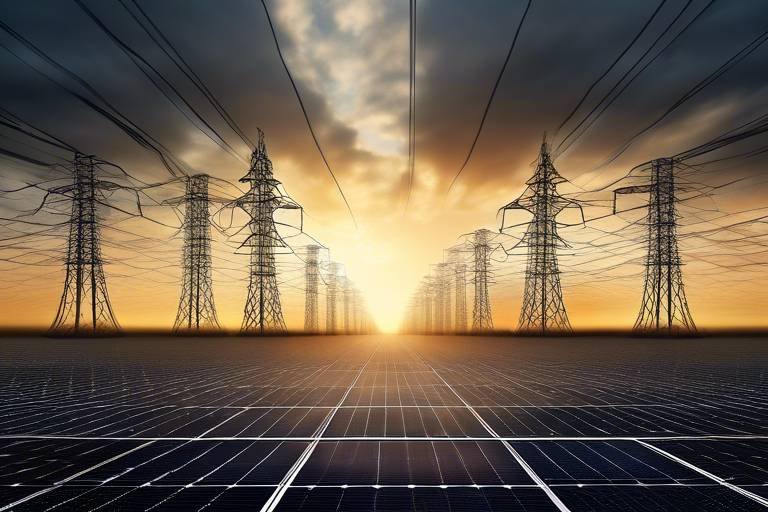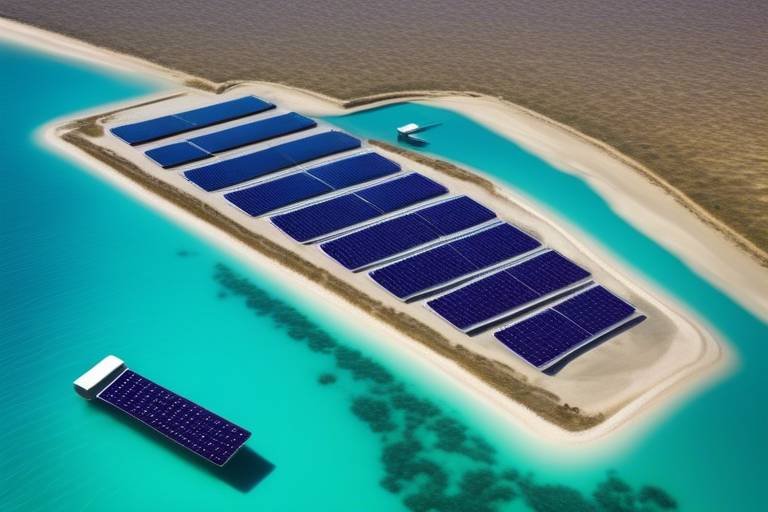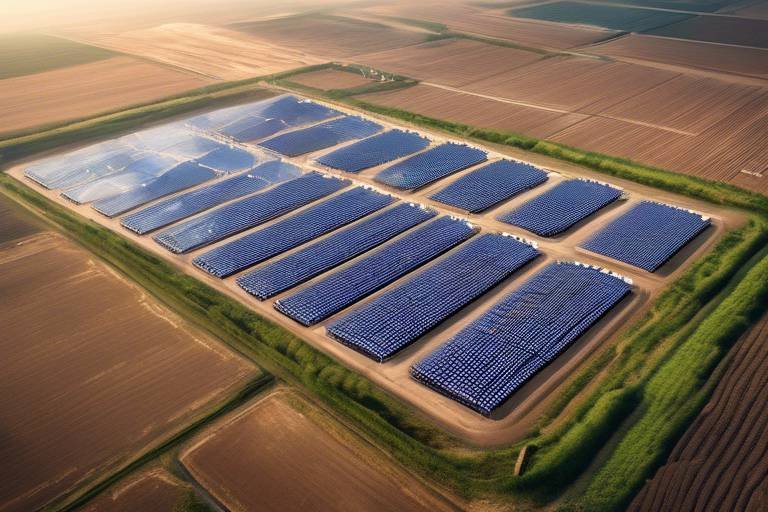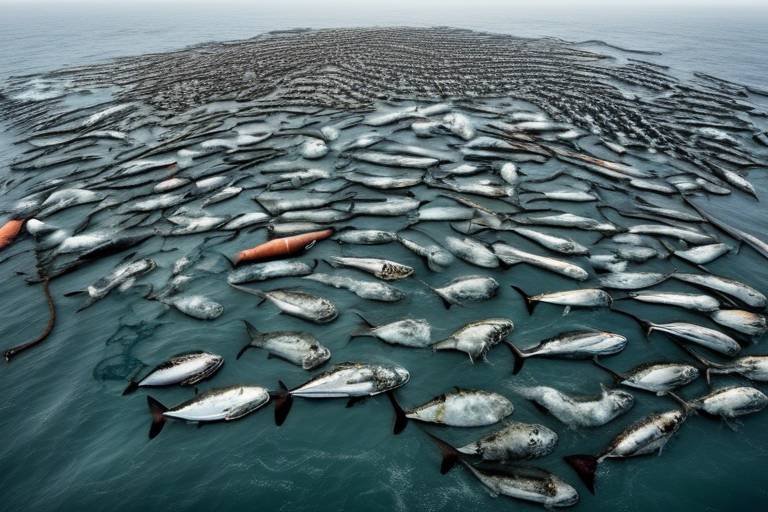A European Supergrid: An Answer to Renewable Energy's Unreliability?
The world is witnessing a significant shift towards renewable energy sources as we strive to combat climate change and reduce our dependence on fossil fuels. However, one of the biggest challenges we face is the unreliability of these energy sources. Enter the concept of a European Supergrid, a visionary project that aims to revolutionize the way we generate, distribute, and consume energy across Europe. But what exactly is a Supergrid, and how can it address the inherent challenges of renewable energy?
At its core, the European Supergrid is designed to connect various renewable energy sources spread across different countries. Imagine a massive web of interconnected power lines that allows energy to flow freely from areas of abundance to areas of demand. This network can significantly enhance grid stability and ensure that energy is always available when needed, even if the sun isn't shining or the wind isn't blowing. It’s like having a safety net that catches you when you fall—only this net is made of electricity!
So, how does this Supergrid work? By integrating diverse energy sources, such as wind, solar, and hydroelectric power, the Supergrid can facilitate energy sharing among nations. For instance, when solar panels in Spain are producing excess energy on a sunny day, that energy can be transmitted to Germany, where it might be cloudy and energy demand is high. This interconnectedness not only optimizes resource allocation but also reduces the risk of blackouts and enhances overall energy security.
Moreover, the benefits of a Supergrid extend beyond just reliability. It presents an opportunity to reduce greenhouse gas emissions and foster a more sustainable energy landscape. By enabling greater integration of renewables, the Supergrid can help Europe meet its ambitious climate goals while also driving economic growth through the creation of green jobs and innovative technologies. However, as with any monumental project, the path to establishing a European Supergrid is fraught with challenges that must be addressed.
The European Supergrid aims to connect various renewable energy sources across countries, facilitating energy sharing and improving grid stability. This section outlines its fundamental principles and objectives.
A Supergrid offers numerous advantages, including increased energy security, reduced reliance on fossil fuels, and enhanced integration of renewable sources. Here, we delve into these benefits and their implications for Europe.
By diversifying energy sources and routes, a Supergrid can bolster energy security across Europe. This interconnected system can help mitigate risks associated with energy supply disruptions, whether they arise from natural disasters or geopolitical tensions. Imagine a scenario where a storm knocks out power in one region; the Supergrid can reroute energy from neighboring areas, ensuring that homes and businesses remain powered. This is not just a theory—it's a practical solution that can safeguard our energy future.
A robust Supergrid can better withstand supply shocks from natural disasters or geopolitical tensions. Historical instances, such as the energy crisis in 2000, highlight how vulnerable our current systems are. A Supergrid could have provided alternative routes for energy distribution, minimizing the impact of such disruptions. By learning from the past, we can build a more resilient energy infrastructure that protects us from future challenges.
Another significant advantage of the Supergrid is its potential to lower energy costs. By optimizing resource allocation and reducing transmission losses, consumers could see a decrease in their energy bills. For example, when energy is shared across borders, it allows for competitive pricing, benefiting everyone involved. This economic implication is crucial, especially in a time when many households are feeling the pinch of rising energy costs.
The Supergrid plays a crucial role in integrating diverse renewable energy sources, such as wind and solar. By balancing supply and demand effectively, the Supergrid can ensure that renewable energy is utilized to its fullest potential. This synergy is vital in transitioning to a greener future where reliance on fossil fuels diminishes. The more we can harness renewable energy, the closer we get to achieving energy independence and sustainability.
Despite its potential, several challenges hinder the development of a European Supergrid, including regulatory hurdles, financing, and technological limitations. This section outlines these obstacles in detail.
Different regulations across countries can complicate the establishment of a unified Supergrid. The need for harmonization of policies is critical to facilitate cross-border energy trading. Without a cohesive framework, the ambitious goals of the Supergrid may remain just that—ambitious but unachievable. Stakeholders must work together to create policies that encourage collaboration and investment in this transformative project.
Current technologies may not be sufficient to support the ambitious goals of a Supergrid. Significant advancements are required to enhance the capacity and efficiency of energy transmission. For instance, investing in smart grid technology and energy storage solutions will be pivotal in making this vision a reality. The future of energy depends on our ability to innovate and adapt to new challenges.
- What is a European Supergrid? A European Supergrid is an interconnected network designed to facilitate the sharing of renewable energy across European countries.
- How can a Supergrid enhance energy security? By diversifying energy sources and routes, a Supergrid can mitigate risks associated with supply disruptions.
- What are the main challenges to implementing a Supergrid? Key challenges include regulatory barriers, financing issues, and technological limitations.
- How does a Supergrid benefit consumers? A Supergrid can lead to reduced energy costs and increased reliability of energy supply.

[Understanding the European Supergrid]
The concept of a European Supergrid is not just a dream; it's a bold vision aimed at revolutionizing how we generate and consume energy across the continent. Imagine a vast network of power lines that crisscrosses borders, linking renewable energy sources from the windswept coasts of Scotland to the sun-drenched fields of Spain. This interconnected grid is designed to optimize energy sharing, ensuring that when the sun shines brightly in one region, and the wind howls in another, energy can flow seamlessly to where it's needed most.
At its core, the Supergrid is built on the principles of collaboration and efficiency. By connecting different countries and their renewable resources, the Supergrid aims to create a more reliable and resilient energy system. This means that if one area experiences a power shortage due to unfavorable weather conditions, energy can be imported from another region that is enjoying optimal generation conditions. It's like having a safety net for energy supply—one that stretches across nations.
To understand the Supergrid better, let's break down its fundamental objectives:
- Energy Sharing: By allowing countries to share their energy resources, the Supergrid can ensure that surplus energy from one area can be utilized in another, reducing waste and improving overall efficiency.
- Stability: The interconnected nature of the Supergrid helps stabilize the energy supply, balancing out fluctuations caused by intermittent renewable sources like solar and wind.
- Cost Efficiency: By optimizing the use of diverse energy sources, the Supergrid can help lower energy costs for consumers across Europe.
Moreover, the Supergrid is not just about connecting existing energy infrastructure; it's about pioneering new technologies and innovations. For instance, advancements in high-voltage direct current (HVDC) technology are crucial for minimizing energy loss during transmission over long distances. This technology allows for efficient energy transfer, making it feasible to transport electricity from remote renewable sources to urban centers where demand is highest.
In summary, the European Supergrid represents a significant leap towards a sustainable energy future. It embodies the spirit of cooperation among nations, emphasizing that when it comes to energy, we are stronger together. By embracing this interconnected approach, Europe can not only enhance its energy security but also pave the way for a greener, more sustainable future. The road ahead may be challenging, but the potential rewards are too great to ignore.

[Benefits of a Supergrid]
The concept of a European Supergrid is not just a visionary idea; it’s a transformative approach to energy management that promises to reshape the way we think about power generation and consumption across the continent. One of the most compelling aspects of a Supergrid is its ability to enhance energy security. By connecting various renewable energy sources from different countries, the Supergrid creates a diversified energy landscape that can significantly reduce reliance on fossil fuels. Imagine a vast web of energy flowing seamlessly across borders, ensuring that when one region faces a shortfall—be it due to a lack of sunlight or wind—another region can step in to fill the gap. This interconnectedness is crucial in a world where energy demands are constantly evolving.
Moreover, a Supergrid can lead to lower energy costs for consumers. With optimized resource allocation and reduced transmission losses, the economic implications are profound. By harnessing the strengths of various renewable sources, energy can be generated in the most efficient locations and transmitted where it’s needed most. This not only leads to cost savings but also fosters a competitive market that benefits consumers. For example, when energy prices fluctuate due to local supply and demand, the Supergrid can provide alternative sources, stabilizing prices and ensuring affordability.
Another significant benefit is the facilitation of renewable integration. As Europe pushes towards ambitious climate goals, the need for a robust system that can effectively balance supply and demand becomes increasingly critical. The Supergrid can integrate diverse renewable sources such as wind, solar, and hydropower, allowing for a more reliable and consistent energy supply. This is particularly important given the intermittent nature of renewable energy. By pooling resources from various locations, the Supergrid can smooth out the peaks and troughs of energy generation, ensuring that there’s always power available when it’s needed.
Let’s not forget the environmental implications. By promoting the use of renewables and reducing dependence on fossil fuels, a European Supergrid can significantly decrease carbon emissions. This aligns perfectly with Europe’s commitment to achieving net-zero emissions by 2050. As we transition to a greener future, the Supergrid stands as a beacon of hope, symbolizing a collective effort to combat climate change.
In summary, the benefits of a Supergrid are vast and multifaceted. From enhancing energy security and reducing costs to facilitating the integration of renewables and promoting environmental sustainability, the Supergrid presents an exciting opportunity for Europe. It’s not just about connecting power lines; it’s about creating a resilient energy system that can adapt to the challenges of tomorrow.
- What is a European Supergrid? A European Supergrid is an interconnected network designed to link various renewable energy sources across Europe, allowing for efficient energy sharing and improved grid stability.
- How does a Supergrid enhance energy security? By diversifying energy sources and routes, a Supergrid can mitigate risks associated with energy supply disruptions, ensuring a more reliable energy supply.
- What are the economic benefits of a Supergrid? A Supergrid can lead to lower energy costs through optimized resource allocation and reduced transmission losses, benefiting consumers and promoting a competitive market.
- How does a Supergrid facilitate renewable energy integration? It enables the pooling of diverse renewable energy sources, helping to balance supply and demand effectively, thus addressing the intermittent nature of renewables.
- What environmental benefits does a Supergrid offer? By promoting the use of renewable energy and reducing fossil fuel dependence, a Supergrid can significantly lower carbon emissions, supporting Europe's climate goals.

[Enhanced Energy Security]
When we talk about energy security, it’s like discussing the backbone of a nation’s infrastructure. Imagine a giant spider web, intricately woven and resilient, where every strand represents a different energy source. A European Supergrid aims to enhance this web by connecting various countries, allowing them to share energy resources seamlessly. This interconnectedness not only diversifies energy sources but also creates multiple routes for energy flow, making the entire system more robust and less susceptible to disruptions.
Think about it: if one country faces a sudden energy shortage due to a natural disaster or a political crisis, the Supergrid can act like a safety net. For instance, if a wind farm in Germany is producing excess energy while solar panels in Spain are underperforming due to cloudy weather, the Supergrid can redistribute energy where it’s needed most. This flexibility is crucial for maintaining stability across the continent, especially in times of crisis.
To illustrate this point further, let’s consider some potential scenarios where enhanced energy security through a Supergrid could make a significant difference:
- Natural Disasters: In the event of a hurricane or earthquake that disrupts local energy production, neighboring countries can quickly provide assistance.
- Geopolitical Tensions: If one country faces sanctions or trade restrictions, the Supergrid can help mitigate the impact by sourcing energy from allies.
- Unexpected Demand Spikes: During extreme weather events, energy consumption can skyrocket. A Supergrid allows for immediate access to additional resources from less affected areas.
The beauty of a Supergrid lies in its ability to create a resilient energy ecosystem. By diversifying energy sources, countries can reduce their reliance on any single energy provider, which is akin to not putting all your eggs in one basket. This diversification not only strengthens energy security but also promotes a more sustainable and environmentally friendly energy landscape.
However, achieving this level of interconnectedness isn’t without its challenges. Each country has its own energy policies, regulations, and infrastructure capabilities, which can complicate the establishment of a unified Supergrid. The need for harmonized regulations and collaborative efforts among nations cannot be overstated. It’s like trying to play a symphony where each musician has a different sheet of music; without coordination, the result is chaos rather than harmony.
In conclusion, enhancing energy security through a European Supergrid is not just a lofty ideal; it’s a practical solution to the energy challenges we face today. By fostering collaboration and resource sharing, we can create a more resilient and reliable energy future for all of Europe. The journey may be complex, but the rewards are undoubtedly worth the effort.
Q1: What is a European Supergrid?
A European Supergrid is an interconnected network designed to facilitate the sharing of renewable energy resources across various countries in Europe, enhancing grid stability and energy security.
Q2: How does a Supergrid improve energy security?
By diversifying energy sources and providing multiple pathways for energy flow, a Supergrid can mitigate risks associated with supply disruptions, such as natural disasters or geopolitical tensions.
Q3: What challenges does the Supergrid face?
Challenges include regulatory hurdles, the need for harmonization of policies across countries, and technological limitations that must be addressed to make the Supergrid a reality.

[Resilience to Supply Shocks]
Imagine waking up one morning to find that your city has been hit by a natural disaster, or perhaps geopolitical tensions have escalated, leading to sudden energy supply disruptions. In such scenarios, the resilience of our energy systems becomes paramount. A European Supergrid holds the potential to transform how Europe responds to these supply shocks by creating a robust network that can adapt and recover quickly.
The interconnected nature of a Supergrid means that energy can be sourced from multiple locations, providing a safety net during crises. For instance, if one region experiences a power outage due to a storm, neighboring areas can step in to supply the needed energy. This diversification of energy sources not only enhances reliability but also reduces the overall vulnerability of the energy system. Think of it as a safety net that catches you when you fall, ensuring that the lights stay on even when the unexpected happens.
Historically, Europe has faced significant challenges due to supply shocks. For example, the 2009 gas dispute between Russia and Ukraine led to widespread energy shortages across Europe. In such cases, a Supergrid could have allowed for a more agile response, redistributing energy from less affected areas to those in need. By minimizing dependency on a single energy source or route, Europe can create a more resilient and reliable energy future.
Furthermore, the Supergrid would enable energy storage solutions, such as batteries and pumped hydro storage, to play a vital role in maintaining stability during supply shocks. These technologies can store excess energy generated during peak production times and release it during shortages, ensuring that energy supply remains consistent. In essence, the Supergrid acts like a well-stocked pantry, ready to provide sustenance when resources become scarce.
To illustrate the potential impact of a Supergrid, consider the following table that compares the resilience of traditional energy systems versus a Supergrid:
| Feature | Traditional Energy Systems | European Supergrid |
|---|---|---|
| Energy Source Diversification | Limited to local sources | Multiple sources across regions |
| Response Time to Disruptions | Slow, often reactive | Fast, proactive adjustments |
| Storage Capabilities | Minimal | Advanced storage solutions |
| Overall Resilience | High vulnerability | Enhanced resilience |
In conclusion, the resilience to supply shocks provided by a European Supergrid is not just a theoretical concept; it is a necessary evolution in how we think about energy distribution. By fostering interconnectedness and flexibility, the Supergrid can ensure that Europe is prepared for the unexpected, reinforcing energy security in a rapidly changing world. So, the next time you think about energy, remember that a Supergrid isn't just about powering homes—it's about powering a resilient future.
- What is a European Supergrid? A European Supergrid is an interconnected network designed to share renewable energy across different countries, enhancing energy stability and reliability.
- How does a Supergrid improve energy security? By diversifying energy sources and routes, a Supergrid can reduce dependency on single sources, making the energy system more resilient to disruptions.
- What are the main challenges in implementing a Supergrid? Key challenges include regulatory barriers, financing issues, and technological limitations that need to be addressed for successful implementation.

[Reduced Energy Costs]
One of the most compelling advantages of a European Supergrid is its potential to significantly reduce energy costs. Imagine a scenario where energy is not just produced in one location but is shared seamlessly across borders, optimizing resource allocation and minimizing waste. This interconnectedness can lead to a more efficient energy market, where supply meets demand in real-time, reducing the need for expensive backup power sources.
When we talk about transmission losses, we're referring to the energy that gets lost as electricity travels through the grid. In traditional systems, these losses can be substantial, often accounting for up to 10% of the total energy generated. However, a Supergrid, with its advanced infrastructure and technology, aims to minimize these losses. By utilizing high-voltage direct current (HVDC) technology, for example, energy can be transmitted over long distances with significantly lower losses compared to conventional alternating current (AC) systems.
Moreover, the Supergrid can enhance competition among energy suppliers, driving down prices for consumers. When energy markets are interconnected, suppliers can offer their services across a wider area, leading to more competitive pricing. Think of it as a marketplace where buyers have access to multiple vendors, each vying for their business. This competition can lead to lower prices and better service for consumers.
In addition, the integration of renewable energy sources—like wind and solar—through a Supergrid can help stabilize prices. Renewable energy is often cheaper than fossil fuels, especially as technology advances and production scales up. By facilitating the use of these cleaner energy sources, the Supergrid can help ensure that energy prices remain low and predictable. For instance, during periods of high renewable output, excess energy can be shared across borders, preventing local surpluses from driving prices down while still ensuring that all regions have access to affordable energy.
To further illustrate the potential savings, consider the following table that outlines the projected cost reductions associated with a European Supergrid:
| Cost Factor | Traditional Grid | Supergrid | Projected Savings |
|---|---|---|---|
| Transmission Losses | 10% | 3% | 7% reduction |
| Energy Prices | $100/MWh | $80/MWh | $20/MWh reduction |
| Backup Energy Costs | $50/MWh | $30/MWh | $20/MWh reduction |
In conclusion, the European Supergrid holds the promise of not only enhancing energy security and integrating renewables but also reducing energy costs significantly. As countries invest in this ambitious project, we can expect to see more affordable energy bills and a more sustainable energy future.
Q: How will the Supergrid affect my energy bills?
A: The Supergrid is expected to lower energy costs by reducing transmission losses and increasing competition among energy suppliers.
Q: What technologies will be used in the Supergrid?
A: Technologies like high-voltage direct current (HVDC) will be utilized to improve efficiency in energy transmission.
Q: Will the Supergrid support renewable energy?
A: Yes, the Supergrid is designed to facilitate the integration of various renewable energy sources, making them more accessible and reliable.

[Facilitating Renewable Integration]
The concept of a European Supergrid is not just a grand vision; it is a crucial framework for the effective integration of renewable energy sources across the continent. Imagine a vast network of interconnected power lines that can transport energy from wind farms in the north to solar fields in the south, all while ensuring that electricity supply meets demand in real-time. This is the essence of the Supergrid, which plays a pivotal role in balancing the intermittent nature of renewable energy. With wind and solar power being heavily reliant on weather conditions, the ability to share energy across borders becomes essential. For instance, when the sun is shining brightly in Spain but the wind isn't blowing in Germany, the Supergrid allows for an efficient transfer of electricity, thus minimizing waste and maximizing resource use.
One of the key advantages of a Supergrid is its capacity to facilitate the integration of a diverse range of renewable energy sources. By connecting various countries, it enables a mix of energy production that can smooth out fluctuations in generation. Picture this: a country that primarily relies on solar energy during the day can export its excess power to neighboring countries that may be experiencing higher demand or lower production. Conversely, during the night, when solar generation drops, these countries can import energy from regions with strong wind production. This interconnectedness not only enhances energy security but also promotes a more sustainable energy future.
To illustrate the potential impact of a Supergrid on renewable integration, consider the following table that outlines various renewable sources and their geographical advantages:
| Renewable Source | Optimal Location | Peak Production Times |
|---|---|---|
| Solar Energy | Southern Europe (e.g., Spain, Italy) | Daytime, especially summer |
| Wind Energy | Northern Europe (e.g., Denmark, Germany) | Nighttime and winter months |
| Hydropower | Central Europe (e.g., Switzerland, Austria) | Year-round, with variations based on rainfall |
As we can see, the geographical distribution of renewable resources varies significantly across Europe. This variability underscores the importance of a Supergrid; it allows for the pooling of resources and ensures that energy generation and consumption are aligned. Furthermore, the Supergrid can enhance the stability of the grid by providing a larger buffer against fluctuations in supply and demand. By enabling energy trading between countries, it not only promotes efficiency but also encourages investment in renewable technologies, as countries can rely on each other to meet their energy needs.
However, the journey toward a fully operational European Supergrid is not without its challenges. As we delve deeper into the intricacies of this ambitious project, we must also address the regulatory and technological hurdles that stand in the way. Nevertheless, the potential for a cleaner, more reliable energy future is worth the effort. The integration of renewable energy sources through a Supergrid is not just a dream; it is a necessity for a sustainable Europe.
- What is a European Supergrid?
A European Supergrid is an interconnected network that facilitates the sharing and distribution of renewable energy across different countries in Europe. - How does a Supergrid help with renewable energy integration?
It allows for the balancing of energy supply and demand by connecting regions with varying renewable energy outputs, thus optimizing resource use. - What are some challenges faced in implementing a Supergrid?
Challenges include regulatory barriers, technological limitations, and the need for significant investment in infrastructure. - Can a Supergrid reduce energy costs?
Yes, by optimizing resource allocation and reducing transmission losses, a Supergrid can lead to lower energy costs for consumers.

[Challenges to Implementation]
The journey towards establishing a European Supergrid is not without its hurdles. While the vision of a seamless, interconnected energy network across Europe is enticing, several significant challenges stand in the way of its realization. One of the most pressing issues is the complex web of regulatory and policy barriers that exist across different nations. Each country has its own set of energy regulations, which often leads to a lack of uniformity in how energy is produced, distributed, and consumed. This fragmentation can create a maze of compliance issues for energy companies looking to operate across borders. As a result, there is a pressing need for harmonization of policies to facilitate cross-border energy trading and ensure that the Supergrid operates efficiently.
Another significant challenge lies in the technological limitations of current infrastructure. The existing grid systems in many countries are outdated and may not be equipped to handle the increased demand and complexities that a Supergrid would introduce. For example, integrating diverse renewable energy sources like wind and solar requires advanced technologies that can manage fluctuations in energy supply and demand. This means that not only do we need to upgrade our existing infrastructure, but we also need to invest in innovative technologies such as smart grids, energy storage solutions, and advanced transmission systems that can facilitate the efficient movement of energy across vast distances.
Moreover, the financing of such an ambitious project poses another layer of complexity. The initial investment required to develop the Supergrid is substantial, and securing funding from various stakeholders—including governments, private investors, and energy companies—can be a daunting task. This challenge is compounded by the fact that the benefits of a Supergrid, such as reduced energy costs and improved energy security, may not be immediately apparent. Therefore, convincing stakeholders to invest in a long-term project that may take years to realize its full potential can be a significant barrier.
In summary, while the concept of a European Supergrid holds great promise for enhancing the reliability and efficiency of renewable energy across the continent, it is clear that a concerted effort is needed to overcome the various challenges it faces. From regulatory harmonization to technological advancements and securing necessary financing, each obstacle must be addressed with thoughtful strategies and collaborative efforts among European nations.
- What is a European Supergrid?
A European Supergrid is an interconnected network designed to share renewable energy sources across different countries in Europe, enhancing energy reliability and efficiency.
- What are the main challenges in implementing a Supergrid?
Key challenges include regulatory barriers, technological limitations, and financing issues that complicate the establishment of a unified energy network.
- How can a Supergrid benefit Europe?
A Supergrid can improve energy security, reduce reliance on fossil fuels, and facilitate the integration of renewable energy sources, leading to lower energy costs.
- What technologies are needed for a Supergrid?
Technological advancements such as smart grids, energy storage solutions, and advanced transmission systems are crucial to support the ambitious goals of a Supergrid.

[Regulatory and Policy Barriers]
The journey towards establishing a European Supergrid is fraught with regulatory and policy barriers that can feel like navigating a maze without a map. Each country in Europe has its own set of rules and regulations governing energy production, distribution, and consumption. This patchwork of policies can create significant challenges for the seamless integration of a Supergrid. Imagine trying to assemble a jigsaw puzzle where each piece is from a different set; that’s what policymakers are up against.
One of the primary hurdles is the lack of harmonization among national regulations. Countries often have different standards for grid access, connection procedures, and energy trading mechanisms. For instance, while one country may prioritize renewable energy sources and provide incentives for their integration, another may still heavily rely on fossil fuels and have policies that discourage the transition to greener alternatives. This inconsistency can create friction and uncertainty for energy producers and investors looking to participate in a unified European energy market.
Moreover, the absence of a cohesive regulatory framework can lead to inefficiencies in energy trading. When countries have their own rules, it complicates cross-border electricity exchanges, resulting in higher costs and wasted resources. To illustrate, consider a situation where wind energy generated in one country could easily supply demand in another, but due to regulatory barriers, that energy remains stranded. This not only affects the profitability of renewable projects but also hampers the overall goal of reducing carbon emissions across Europe.
To tackle these regulatory challenges, there is a pressing need for a unified policy approach. The European Union (EU) has made strides in this direction, but the implementation of consistent energy policies across member states remains a work in progress. The establishment of a European Energy Union could serve as a vital step towards creating a framework that facilitates cross-border energy trading and investment in renewable sources.
In addition, engaging in stakeholder consultations can help ensure that the voices of all parties—governments, energy producers, consumers, and environmental groups—are heard during the policymaking process. This collaborative approach can lead to more effective regulations that not only promote the Supergrid but also align with the broader goals of sustainability and energy security.
In summary, while the vision of a European Supergrid is promising, the regulatory and policy barriers present a significant challenge. Overcoming these obstacles will require concerted efforts from governments, regulatory bodies, and industry stakeholders to create a cohesive and supportive environment for renewable energy integration. Only then can Europe truly harness the potential of its diverse renewable resources and pave the way for a more resilient energy future.
- What is a European Supergrid?
A European Supergrid is an interconnected network designed to facilitate the sharing of renewable energy across various European countries, enhancing grid stability and efficiency.
- Why are regulatory barriers significant for the Supergrid?
Regulatory barriers can create inconsistencies in energy policies across countries, complicating cross-border energy trading and investment in renewable sources.
- How can the EU help in overcoming these barriers?
The EU can play a crucial role by establishing a unified policy framework that harmonizes regulations and promotes collaboration among member states.
- What are the benefits of a Supergrid?
A Supergrid can enhance energy security, reduce reliance on fossil fuels, and facilitate the integration of renewable energy sources, leading to lower energy costs and a more sustainable energy future.

[Technological Limitations]
When we talk about the ambitious vision of a European Supergrid, it's essential to recognize that the road ahead is not without its bumps. One of the most significant hurdles is the technological limitations that currently exist. While the idea of a highly interconnected energy network sounds fantastic, we must face the reality that our existing technologies may not be up to the task. So, what are these limitations that could potentially stall the progress of this grand vision?
First off, let’s consider the current infrastructure. Much of Europe still relies on traditional energy grids that were designed decades ago, primarily for fossil fuels. These grids are not equipped to handle the variable nature of renewable energy sources like solar and wind. The intermittent nature of these energy sources means that energy production doesn’t always match consumption. Thus, the existing grids struggle to balance supply and demand effectively. To tackle this issue, advanced grid management systems and energy storage solutions must be developed. Technologies like smart grids and energy storage systems (like batteries) are vital for managing these fluctuations.
Moreover, the integration of renewable energy sources into the Supergrid is another challenge. Each type of renewable energy comes with its own set of technological requirements. For instance, offshore wind farms require different infrastructure compared to solar farms. The technological diversity means that a one-size-fits-all approach won't work. Instead, we need a combination of technologies that can seamlessly work together. This can be a daunting task, especially when considering the need for interoperability among various systems.
To illustrate, let’s look at some of the key technologies that need to evolve:
| Technology | Current Status | Needed Advancements |
|---|---|---|
| Smart Grids | Limited deployment | Widespread implementation and integration with existing systems |
| Energy Storage | Developing | Higher capacity and efficiency, cost reduction |
| Transmission Technologies | Conventional methods | High-voltage direct current (HVDC) systems for long-distance transmission |
Additionally, we cannot overlook the need for data management technologies. As the Supergrid will generate vast amounts of data, effective data analytics and management systems are crucial for optimizing energy distribution and consumption. This will require robust cybersecurity measures to protect sensitive information and ensure the integrity of the energy grid.
In conclusion, while the dream of a European Supergrid is enticing, we have to face the reality of the technological limitations that stand in its way. From outdated infrastructure to the need for advanced energy management systems, the challenges are significant. However, with ongoing research and development, we can hope for breakthroughs that will help turn this vision into a reality. The journey may be long, but the potential rewards—enhanced energy security and a greener future—are well worth the effort.
- What is a European Supergrid? A European Supergrid is an interconnected network designed to share renewable energy across countries, improving grid stability and reliability.
- Why are technological limitations a concern? Existing technologies may not support the variable nature of renewable energy, making it challenging to balance supply and demand.
- What advancements are needed for a Supergrid? We need improved smart grids, energy storage solutions, and advanced transmission technologies to make the Supergrid feasible.
Frequently Asked Questions
- What is a European Supergrid?
A European Supergrid is an interconnected network designed to enhance the reliability and efficiency of renewable energy distribution across various countries in Europe. By connecting different renewable energy sources, it aims to facilitate energy sharing and improve overall grid stability.
- How does a Supergrid enhance energy security?
By diversifying energy sources and routes, a Supergrid can significantly bolster energy security. This interconnectedness allows countries to share resources during supply disruptions, reducing reliance on any single energy source and mitigating risks associated with geopolitical tensions or natural disasters.
- What are the economic benefits of a Supergrid?
A Supergrid can lead to lower energy costs by optimizing resource allocation and minimizing transmission losses. This means that energy can be delivered more efficiently, ultimately resulting in cost savings for consumers and businesses alike.
- How does the Supergrid facilitate renewable energy integration?
The Supergrid plays a crucial role in integrating various renewable energy sources, such as wind and solar, by balancing supply and demand effectively. This integration helps to ensure that renewable energy can be harnessed efficiently, even when production fluctuates.
- What challenges does the Supergrid face in its implementation?
Several challenges hinder the development of a European Supergrid, including regulatory hurdles, financing issues, and technological limitations. These obstacles need to be addressed to create a unified energy network that can function effectively across borders.
- Why are regulatory and policy barriers a concern for the Supergrid?
Different regulations across countries can complicate the establishment of a unified Supergrid. Harmonizing policies is essential to facilitate cross-border energy trading, ensuring that all participating nations can benefit from the interconnected system.
- What technological advancements are necessary for the Supergrid?
Current technologies may not be sufficient to support the ambitious goals of a Supergrid. Advancements in energy storage, transmission technologies, and grid management systems are crucial to making this vision a reality and ensuring that the grid can handle fluctuating energy supplies.



















